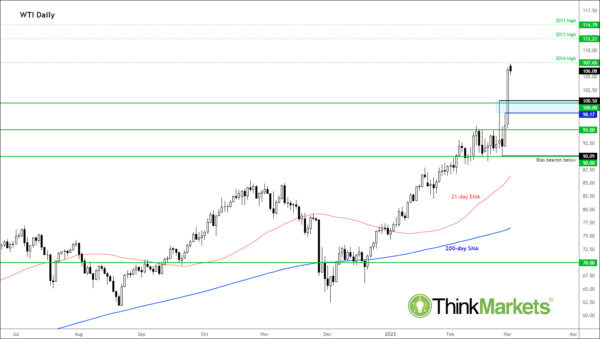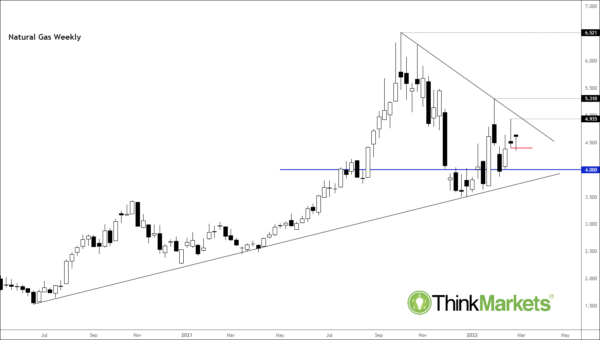- Why are oil and gas prices soaring?
- Is there hope for a drop in energy prices?
- What do the charts of WTI and NatGas tell us?
In response to a worsening of geopolitical environment concerning Russia, Ukraine and the West, key commodity prices have been surging, not least crude oil and natural gas. We have also seen wheat and other grains rise sharply, while safe-haven flows into government bonds, gold and silver have sent their prices higher, too. But as Russia is the largest exporter of gas and the second largest exporter of crude oil, it is these markets that have been under the spotlight the most. So, why exactly are energy prices soaring and how should speculators approach and trade these markets?
Sanctions on Russia
Western sanctions on Russia have so far excluded energy shipments, but traders have pushed up oil and coal prices sharply higher anyway, with gas prices also remaining supported. Brent crude surged 9% Tuesday to rise north of $107 a barrel, while WTI jumped to $106.
The crude oil market was already tight, even before the invasion of Ukraine by Russia. But now there are concerns that because of the ongoing situation, foreign refiners are going to be very reluctant to buy crude oil from Russia, with some banks also refusing to finance shipments of Russian commodities. In effect, this is the same as an actual drop in Russian exports of crude oil. Moscow must find ways to continue selling its oil, otherwise there is the risk of an even bigger oil-price shock.
The unthinkable would be if fresh measures are introduced that would directly target oil and gas exports from Russia, or if the latter retaliates by turning off supplies of these commodities to its western neighbours in Europe. An energy-dependant Europe will want to avoid this situation, nearly at all costs. But traders are not taking any chances as fighting in Ukraine intensifies, while international payments to and from Russia become increasingly very difficult with the West’s decision to exclude several Russian banks from the SWIFT global financial messaging system.
Is there any hope for oil prices to fall back?
In short, there is very little hope for a massive oil-price slide in the short-term outlook, and in any case while the Ukraine situation remains perilous. But in the not-too-distant future, there is a possibility we might see prices fall back from these multi-year highs.
Let’s not forget that making the situation worse is the OPEC and its allies, including Russia of course. The group is likely to stick to their existing policy at Wednesday’s meeting of increasing output only gradually, by 400,000 barrels per day every month. The OPEC+ will likely suggest that Russia’s invasion of Ukraine has not affected the OPEC+ deal.
Ignoring the Ukraine-related price movements, until the OPEC releases more crude to the market, the chances of a prolonged period of oil-price weakness remains slim. Indeed, government measures such as Strategic Petroleum Reserve (SPR) releases are not having the intended impact, as we have already seen. The IEA’s decision to release 60 million barrels from reserves on Tuesday was like a drop in the ocean and failed to put a lid on prices.
Another hope for lower oil prices is the potential for Iranian oil to make a return, if there is progress in Tehran’s nuclear talks. But this is a slightly longer-term prospect.
What does the chart say as WTI takes out $100 barrier?
The big rally in oil prices has led to the breakdown of several resistance and psychologically-important levels, repeatedly unravelling the bears’ attempts to catch the top. Shorting oil is akin to playing with fire in this type of market environment and requires a strong set of technical skills and discipline. We would not recommend it for inexperienced traders, especially when prices are making higher highs and higher lows as they have been of late. Buying the dips might feel very uncomfortable at these elevated levels, but that has been the strategy that has undoubtedly worked so far and may continue to do so for a while yet. Only when we see a distinct reversal pattern should traders actively look for sell trades.
Indeed, with the $100 level broken decisively, the path of least resistance continues to remain to the upside for oil. Bullish traders have their eyes set on levels that had acted as major resistance in the past. Among them, $107.50ish was the high set in 2014, just before when the OPEC-US price war sent crude oil tumbling. Just because this level marks a prior peak doesn’t mean oil prices will find resistance here, as after all the fundamental picture is totally different now.
Above the 2014 peak is the net psychologically-important level of $110, around which we may see some profit taking. Thereafter are the 2013 and 2011 highs at $112.20 and $114.80, respectively, with the latter coming in just shy of the next psychological level of $115.00.
On the downside, levels that had previously offered resistance should offer at least some support, potentially providing bounceable trading opportunities. Some of these levels come in around the $100.50 to $98.00 range. The next level below this zone is at $95.00.
The last major low prior to the latest breakout was made around $90.00. This level is now the line in the sand. For as long as oil prices hold above $90.00, the technical bias would remain bullish. If and when this level is broken, or we see a similar reversal at higher levels first, then one can entertain the idea of shorting crude oil.
NatGas gearing up for a potential break out
Natural gas prices have remained supported amid the energy crunch in Europe and elsewhere, and in light of the invasion of Ukraine by Russia. Like crude oil, the path of least resistance is to the upside for NatGas. Unlike oil though, we haven’t seen a massive break out yet, but may well do, should Russia retaliate to western sanctions by turning off its gas supplies to Europe. The potential is therebefore for a breakout, and we would favour buying dips to support.
With last week’s inverted hammer candle failing to bring out the bears, it looks like NatGas is set for a short-squeeze rally in the coming days. Thus, any stops that might be resting above last week’s high just below $5.000 could be subject to a raid, leading to further technical buying above that zone. The January high at $5.310 is the next upside target, followed by last year’s peak at $6.521.
On the downside, a potential break below support at $4.500 could clear the way for technical selling towards the next support at $4.000, followed by the range low at $3.500 next.















